Understanding Contingency vs Retained Search: An In-Depth Tutorial for IT Recruitment
Explore the key differences and benefits of contingency vs retained search in IT recruitment.
Overview
The importance of aligning talent with technology needs cannot be overstated. This article delves into the distinctions between contingency and retained search models in IT recruitment, underscoring their suitability for varied hiring requirements. Contingency recruitment stands out as an effective strategy for swiftly filling lower-tier positions, operating on a pay-for-performance model. Conversely, retained search is more appropriate for higher-level or specialized roles, providing a comprehensive vetting process and fostering long-term partnerships that enhance candidate fit and organizational alignment.
In addition, understanding these recruitment models is essential for IT Directors facing unique challenges. For instance, contingency recruitment allows for quick placements, which can be critical in a fast-paced tech environment. On the other hand, the thorough approach of retained search ensures that organizations attract top-tier talent, aligning with their strategic goals. Thus, recognizing the right model for specific hiring needs can significantly impact organizational success.
Ultimately, the choice between these recruitment strategies hinges on the specific requirements of the role and the organization’s long-term vision. By tailoring recruitment solutions to these needs, IT leaders can better navigate the complexities of talent acquisition, ensuring a more effective alignment between their workforce and technological demands.
Introduction
In the competitive landscape of IT recruitment, organizations face a critical decision: choosing between contingency and retained search models. This choice is not merely procedural; it is pivotal for aligning talent with technology needs. Each approach presents distinct advantages, catering to diverse hiring requirements—from swiftly filling entry-level positions to meticulously sourcing high-level executives. As the demand for specialized talent intensifies, understanding the nuances of these recruitment strategies becomes essential for IT directors seeking to optimize their talent acquisition efforts.
This article delves into the key differences between contingency and retained search. We will highlight their respective benefits, cost considerations, and the strategic implications for organizations navigating the complexities of recruitment in the ever-evolving tech industry. Are you ready to explore how tailored recruitment solutions can enhance your organization’s hiring strategy?
Defining Contingency and Retained Search: Key Concepts
Contingency recruitment represents a model where agencies receive payment solely upon the successful placement of an individual. This approach is particularly advantageous for swiftly filling lower-tier positions without upfront costs, making it a popular choice among organizations aiming to fill roles quickly. In contrast, retained recruitment operates under a contractual agreement, wherein a recruiter, such as Bristow Holland, is compensated with a retainer fee in advance to conduct a thorough search for prospects.
This model is typically employed for higher-level or specialized roles, emphasizing a deeper partnership between the recruiter and the client. Such collaboration facilitates a more tailored and strategic approach to identifying the right candidate, ensuring that the specific needs of the organization are met. This is especially pertinent when evaluating the contingency versus retained search models, which often hinge on the urgency of the hiring need and the level of specialization required. For instance, in the fast-paced IT sector, where demand for skilled professionals is high, companies may opt for contingency recruitment to quickly fill roles.
However, for essential roles that require a unique skill set or cultural fit, executive recruitment becomes invaluable. This model enables a more comprehensive vetting process and a focus on long-term alignment with organizational objectives.
Statistics reveal that 20% of leaders struggle with diversity, equity, and inclusion (DEI) compliance, underscoring the necessity of implementing inclusive hiring practices. The retained search model excels in this regard, often incorporating a commitment to diversity initiatives and bias training, thereby enhancing workplace diversity and belonging.
Current trends for 2025 indicate that flexibility in work arrangements and personalized employee benefits are becoming key priorities for employee retention. As organizations navigate these trends, the selection of a hiring model can significantly influence their capacity to attract and retain top talent.
For instance, employee advocacy is emerging as a vital approach in hiring, with content shared by employees generating considerably more engagement than official brand messages. FastCompany notes that leads produced through employee social marketing convert seven times more than other leads, highlighting the significance of utilizing genuine employee experiences in both contingency and permanent hiring strategies.
In summary, understanding the key differences between contingency versus retained search and permanent hiring models is essential for IT directors seeking to optimize their hiring strategies. By aligning the chosen model with organizational needs and industry trends, companies can enhance their talent acquisition efforts and drive long-term success, particularly with the expert support of Bristow Holland in navigating these complexities.

Advantages of Retained Search in IT Recruitment
Retained sourcing presents numerous advantages in IT hiring, establishing itself as a preferred strategy for organizations aiming to attract top talent in a competitive landscape. The key benefits are manifold:
- Access to Passive Candidates: Retained recruiters excel at engaging passive candidates—those not actively pursuing new opportunities—significantly broadening the talent pool. This access is vital in the tech industry, where skilled professionals often feel content in their current roles but may be receptive to the right opportunity. Bristow Holland’s tailored approach ensures connections with these high-caliber individuals, leveraging extensive industry knowledge to identify the best fits for client needs.
- Thorough Vetting Process: The retained search model facilitates a comprehensive assessment of candidates, ensuring they not only possess the requisite technical skills but also align with the company culture. This meticulous vetting process is crucial for long-term success, as it mitigates the risk of mismatches that can lead to high turnover rates. The increasing focus on organizational culture is underscored by the statistic that employee resource groups (ERGs) have surged from 30% in 2023 to 54% in 2024, emphasizing the significance of cultural fit in recruitment. Bristow Holland’s commitment to understanding both candidates and employers enhances this alignment.
- Long-term Partnership: Engaging in retained search cultivates a collaborative relationship between the recruiter and the client. This partnership improves alignment on hiring objectives and expectations, resulting in more effective hiring strategies tailored to the specific needs of the organization. Bristow Holland’s reputation for exceptional service and customer care ensures that clients feel supported throughout the recruitment process. As noted by Stuart Barnett, Technical Director at WI-Q, “Without Bristow Holland, we wouldn’t have a team. They’ve hired all of our guys and built that whole team that is now driving this product forward.”
- Confidentiality: For sensitive or high-level roles, executive recruitment provides a level of confidentiality that is often critical for both candidates and organizations. This discretion safeguards the interests of all parties involved, particularly when addressing strategic hires.
In 2025, the advantages of executive recruitment are increasingly recognized, with numerous organizations reporting enhanced success rates when comparing contingency versus retained search recruitment models. Research indicates that firms utilizing executive recruitment experience higher placement success rates and lower turnover, underscoring the effectiveness of this method in the tech industry. Furthermore, expert insights emphasize that while initial costs may be higher with retained recruitment, the long-term savings associated with reduced turnover and improved employee engagement frequently outweigh these upfront expenditures.
Mark Stephens highlights that in the comparison of contingency versus retained search, the average total recruiting costs reveal that contingency recruiting expenses over the long term are significantly greater, despite lower upfront fees.
Case studies illustrate the tangible benefits of talent acquisition in IT hiring. For example, organizations that invested in structured onboarding programs alongside talent acquisition strategies reported markedly higher employee retention rates, demonstrating the importance of a comprehensive approach to talent acquisition and management. The case study titled “Impact of Onboarding on Employee Retention” emphasizes that effective onboarding processes are crucial for employee retention, with studies indicating that a robust onboarding experience significantly influences long-term commitment to a company.
As the technology landscape continues to evolve, the strategic benefits of retained hiring will remain a critical factor for IT Directors striving to build high-performing teams, particularly as the sector seeks to enhance gender diversity and address inequalities in tech hiring.
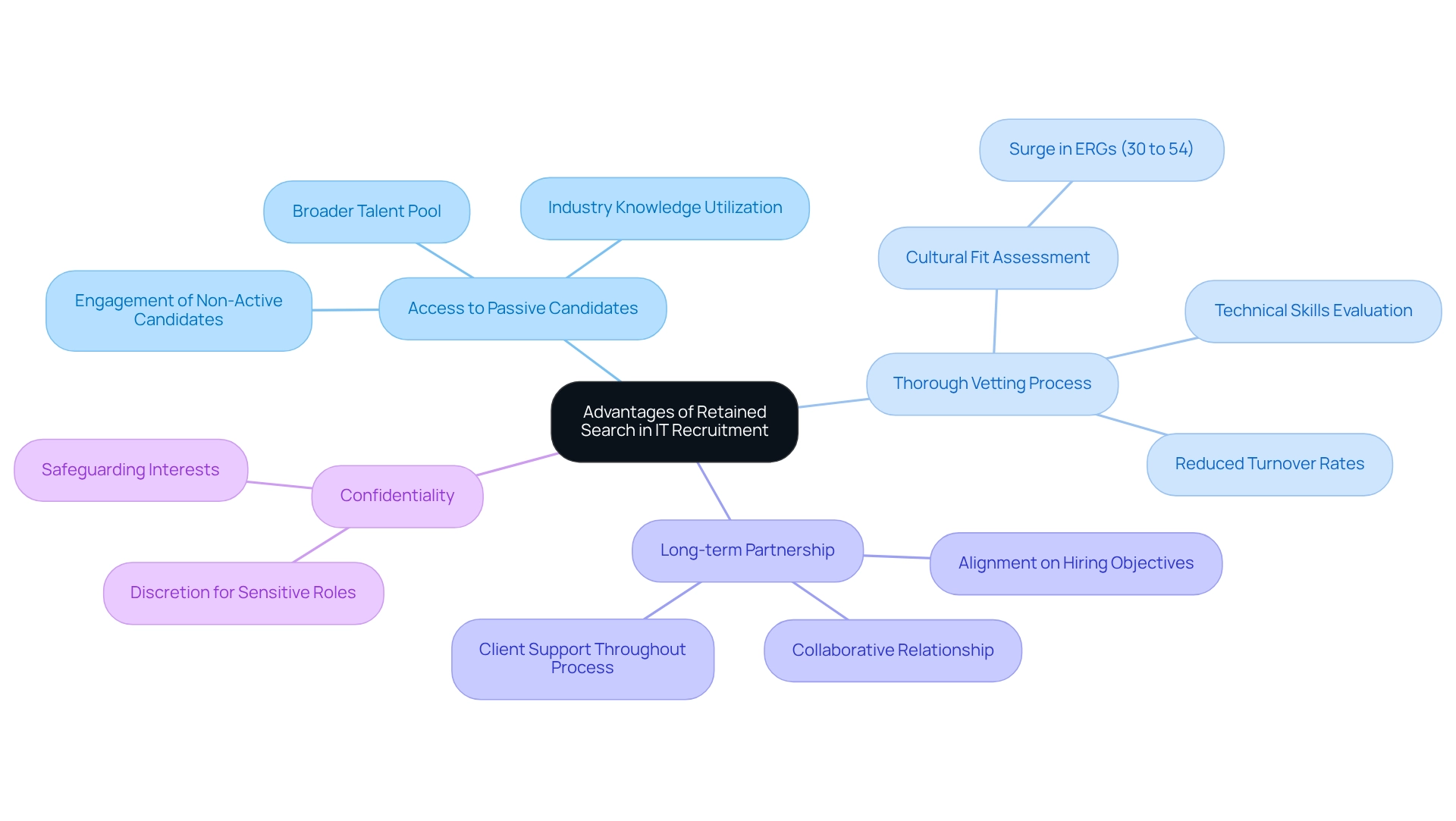
Benefits of Contingency Search for Tech Roles
Contingency search offers distinct advantages, particularly in the realm of tech recruitment.
Cost-Effectiveness: Organizations benefit from a pay-for-performance model, incurring costs only when an individual is successfully placed. This low-risk strategy is especially attractive for filling critical tech positions, enabling companies to allocate resources more efficiently.
Speed: In the fast-paced tech industry, the urgency to fill roles can significantly influence project timelines. Contingency recruiters, such as those at Bristow Holland, are noted for their agility, often operating swiftly to identify and present candidates, thereby minimizing time-to-hire and ensuring that projects remain on schedule.
Diverse Talent Pool: The contingency model grants recruiters access to a wide array of candidates, heightening the likelihood of finding the right fit for various tech roles. This diversity enriches the talent pool and fosters innovation within teams. Bristow Holland’s commitment to high-caliber talent acquisition guarantees that organizations have access to exceptional individuals who can propel their projects forward.
Flexibility: Companies can engage multiple contingency recruiters simultaneously, enhancing their chances of swiftly filling positions without the burden of long-term commitments. This flexibility is crucial for organizations that must adapt quickly to changing market demands.
Statistics reveal that businesses typically favor retained recruitment over contingency for senior positions, particularly at the ‘Head of’ or ‘Assistant Director’ levels and above. However, for many tech roles, the contingency approach proves both effective and efficient. A case study on Twitter illustrates how the platform serves as a valuable hiring tool, highlighting its extensive use among recruiters and the benefits of accessing a diverse candidate pool.
The statistics suggest that Twitter is a significant resource for recruiters, complementing LinkedIn in connecting with skilled candidates.
Expert insights further underscore the benefits of contingency search in tech hiring. Professionals in the field assert that this approach not only enhances the speed and cost-effectiveness of hiring but also aligns seamlessly with the dynamic nature of the tech industry, where the demand for skilled talent is ever-increasing. Industry leaders, including those at Bristow Holland, emphasize that integrating AI in hiring presents opportunities to enhance efficiency, mitigate bias, and improve hire quality, making it a critical consideration for organizations aiming to optimize their contingency hiring processes.
It is essential to recognize that hiring is a linear process aimed at filling vacancies, while talent acquisition represents a strategic approach for long-term hiring needs. This distinction further highlights the strategic significance of contingency hiring.
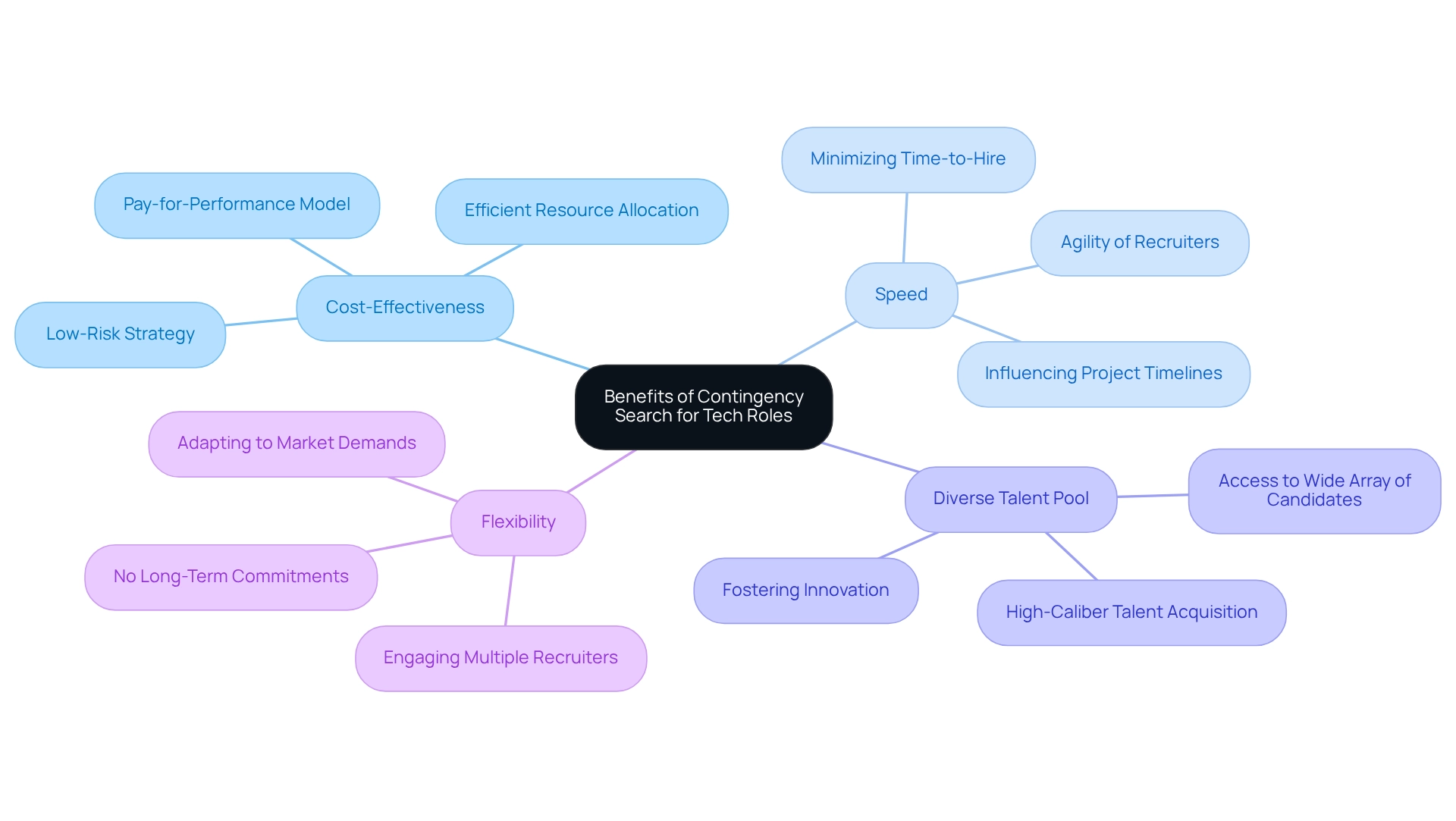
Key Differences Between Contingency and Retained Search
Understanding the key differences between contingency and retained search is pivotal for enhancing recruitment strategies in the tech industry.
Payment Structure: In a contingency search model, payment is contingent upon a successful placement, meaning the agency only receives a fee once a candidate is hired. Conversely, retained search requires an upfront fee, ensuring that the recruiter is compensated for their commitment to the search process, regardless of the outcome. Bristow Holland’s permanent placement fees are set at 20% of the candidate’s first-year base salary, reflecting our dedication to quality and investment in securing the best candidates who align with your company culture. Statistics indicate that refunds in hiring can differ greatly depending on the model applied: generally, a 100% refund is provided if an employee departs within 30 days, 50% within 60 days, and 25% within 90 days. This underscores the financial implications of choosing the right recruitment strategy.
Candidate Focus: Contingency inquiries primarily target active job seekers who are readily available and seeking new opportunities. In contrast, executive searches explore the talent pool more thoroughly, often concentrating on passive candidates—individuals who might not be actively pursuing new positions but possess the skills and experience that match the employer’s requirements. Bristow Holland prioritizes understanding your unique needs and providing tailored solutions, ensuring a faster, more effective hiring process.
Depth of Search: The retained recruitment process usually entails a thorough vetting procedure, including extensive interviews and evaluations to ensure applicants fulfill the specific criteria of the role. This differs from the approach taken in contingency inquiries, which may emphasize speed and quantity, resulting in a greater number of submissions but possibly less qualified individuals. Our commitment to quality means we invest in cutting-edge technology that allows us to identify and engage top-tier candidates faster than the competition, along with hiring exceptional consultants who thrive in a supportive environment. This translates to low turnover, meaning you’ll consistently work with the same dedicated experts who understand your business needs, ensuring continuity and a superior level of service.
Commitment Level: The comparison of contingency versus retained search illustrates that retained recruitment fosters a long-term partnership between the recruiter and the client, emphasizing collaboration and strategic alignment throughout the hiring process. In contrast, contingency recruitment is often more transactional, focusing on immediate placements rather than building lasting relationships. Many clients who previously cycled through multiple low-cost agencies now partner exclusively with Bristow Holland, recognizing that true value lies in expertise and results.
A case study titled ‘The Risk of Traditional Hiring’ illustrates the limitations of conventional hiring methods. Numerous contingency firms may abandon difficult inquiries without informing clients, leading to unfilled positions. This underscores the advantages of dedicated talent acquisition, which focuses on meticulousness and interaction during the hiring process.
Additionally, Krista Bradford, CEO of The Good Search, states, “To choose the appropriate executive recruitment firm, executive recruitment clients must comprehend the differences between contingency versus retained search models.” This expert insight reinforces the importance of understanding these distinctions.
In summary, grasping these key differences is crucial for IT Directors aiming to enhance their hiring processes and attract top talent in a competitive environment.

When to Choose Contingency vs. Retained Search
Deciding between contingency and exclusive recruitment is pivotal, as it can significantly influence hiring outcomes. Understanding the nuances of this decision is essential for aligning talent with technology needs.
Role Level: Exclusive recruitment is typically more effective for executive or highly specialized positions. This method allows for a comprehensive understanding of the role’s requirements and the organizational culture, ensuring a better fit. Conversely, contingency recruitment may suffice for lower-tier positions where urgency trumps the need for thorough investigation.
Urgency: When a role demands swift filling, contingency recruitment can yield faster results, making it an appealing option for organizations facing immediate staffing needs. However, for essential hires where the caliber of the applicant is crucial, executive recruitment is recommended. This approach facilitates a meticulous selection process, which can enhance long-term retention and performance.
Budget Considerations: Organizations with limited budgets may lean towards contingency recruitment due to its lower initial expenses, as fees are incurred only upon successful placement. In contrast, firms prepared to invest in a comprehensive search may prefer retained search, which often yields higher-quality applicants and better strategic alignment with organizational objectives.
Statistical Insights: Understanding the dynamics of talent movement through the hiring funnel is vital. A striking statistic reveals that only 7% of female applicants and 19% of male applicants advance to the interview phase, underscoring potential biases in the hiring process. This data accentuates the importance of a thoughtful hiring strategy, particularly in ensuring equitable opportunities for all applicants, especially women. As we look to the future, it is imperative to encourage more women to pursue careers in tech, where they are well-equipped to excel. Furthermore, hiring consultants can utilize targeted KPIs to enhance specific stages of the hiring funnel, such as applicant experience and offer acceptance rates, which are crucial for improving overall hiring effectiveness. Addressing compensation issues early in the hiring process can also elevate the offer acceptance rate, illustrating the practical implications of hiring strategies.
Long-Term Retention: First-year attrition serves as a significant measure of hiring success, reflecting the turnover of new hires within their first year. This metric aids organizations in evaluating the effectiveness of their hiring strategies and the suitability of candidates within the company culture.
Expert insights emphasize that when hiring specialists, the choice between contingency and retained search should consider the specific requirements of the organization and the role in question. Erik van Vulpen, a recognized authority in hiring, notes that measuring hiring ROI (Return on Investment) is essential for assessing the effectiveness of hiring strategies. This perspective can guide organizations in selecting the most appropriate retrieval model based on their unique circumstances. Moreover, addressing potential compensation issues early in the hiring process can enhance the offer acceptance rate, further demonstrating the practical implications of hiring strategies.
By meticulously evaluating these factors, organizations can make informed decisions that align with their hiring objectives, ultimately contributing to a more balanced representation of women in technology.
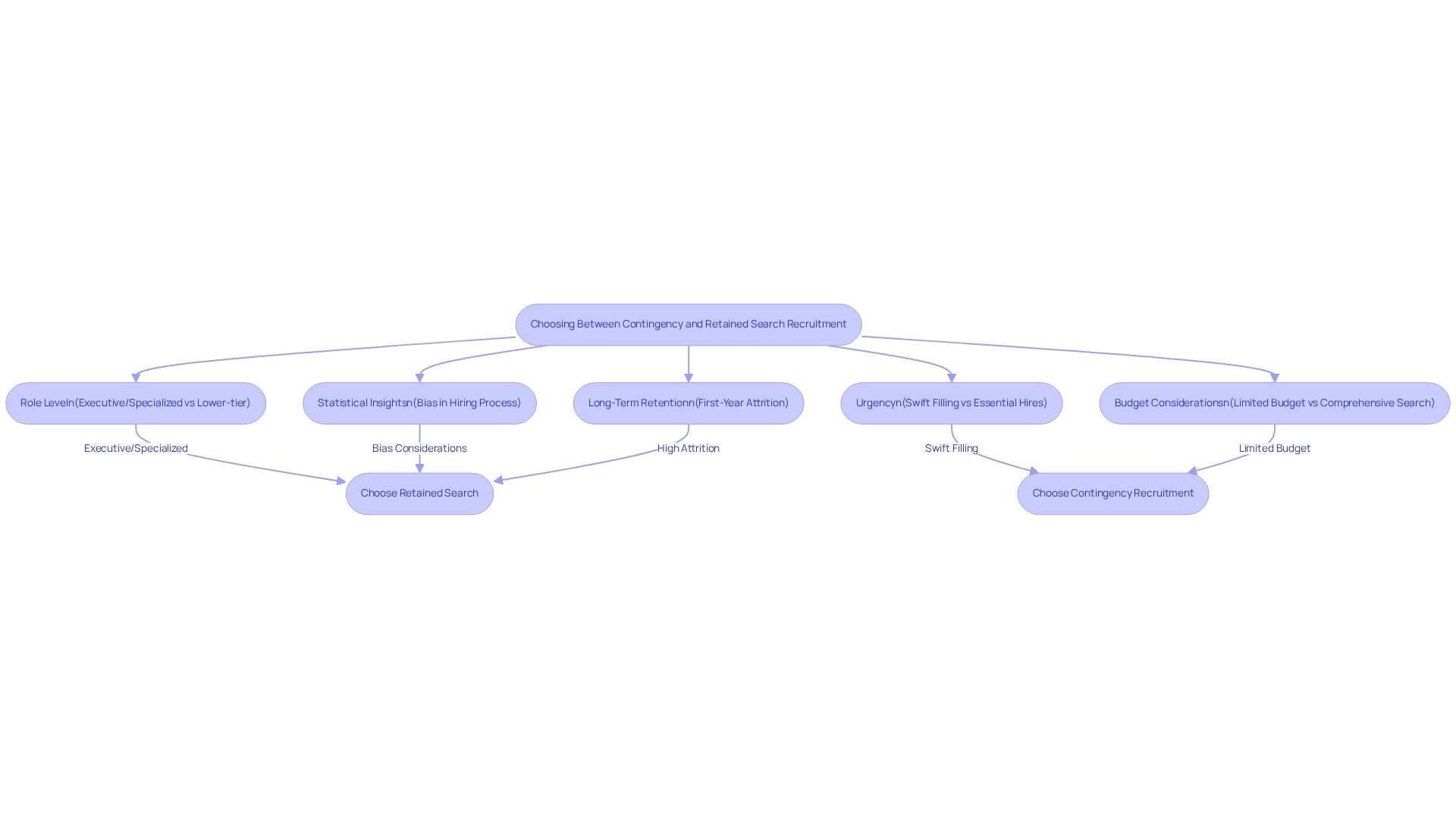
Cost Considerations: Comparing Retained and Contingency Search
Cost factors in contingency versus retained search recruitment are crucial for organizations navigating the complexities of IT hiring. Aligning talent with technology needs is not merely a preference; it’s a necessity for success in today’s competitive landscape.
-
Retained Search Costs: This model typically requires a retainer fee, which can range from 20% to 35% of the individual’s first-year salary. Additional charges may arise for expenses incurred during the inquiry process. Retained recruitment firms, such as Bristow Holland, conduct original research to identify high-performing executives who may not be actively seeking new opportunities. This ensures a more targeted approach to sourcing professionals. Our permanent placement fees are set at 20% of the individual’s first-year base salary, reflecting our commitment to quality and expertise.
-
Contingency Recruitment Costs: Conversely, contingency hiring operates on a pay-per-hire model, where fees are incurred only upon successful placement. These fees typically range from 15% to 25% of the individual’s first-year salary. This model emphasizes speed and quantity, motivating recruitment firms to present a large pool of candidates quickly. This enables clients to engage with various agencies and hire independently.
-
Long-Term Value: While executive recruitment may entail higher initial costs, it often results in superior long-term outcomes. Organizations that utilize executive recruitment frequently experience lower turnover rates and enhanced employee satisfaction, as the candidates sourced are typically a better fit for the organizational culture and role requirements. Bristow Holland invests significantly in advanced technology and exceptional consultants, ensuring our clients benefit from a superior level of service and continuity. Notably, the success rate for filling VP roles through contingent recruitment is approximately 20%, underscoring the challenges associated with finding the right talent through this model alone.
As Krista Bradford, CEO of The Good Search, asserts, ‘To choose the appropriate executive recruitment firm, executive recruitment clients must understand the differences between contingency and retained search in the business models.’ Ultimately, the decision regarding contingency versus retained search in recruitment should be guided by an assessment of company needs, the specific job position, budget constraints, and the desired quality of candidates. Understanding these financial implications can significantly impact the effectiveness of hiring strategies in the competitive tech landscape.
Get in contact with us today!
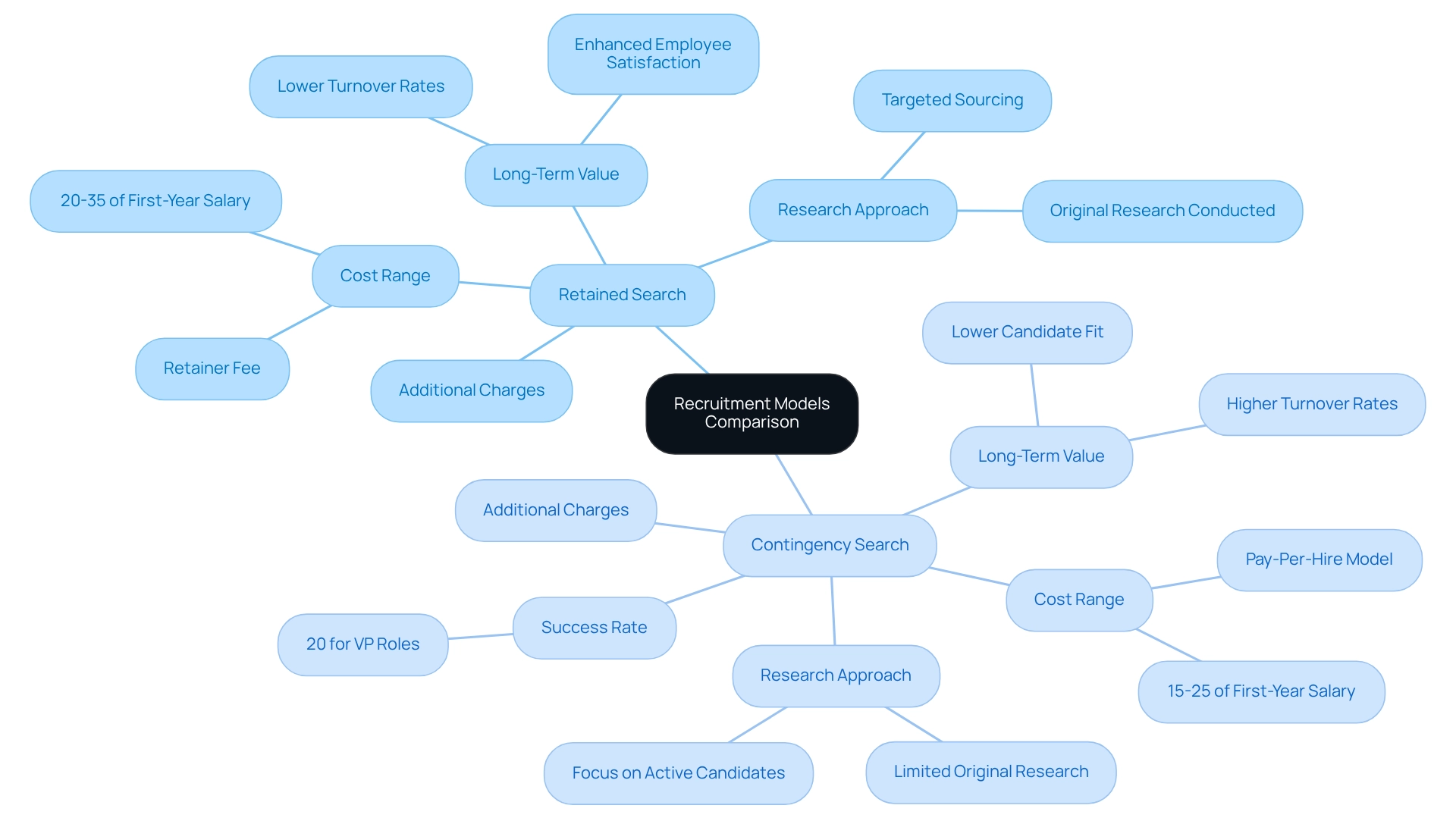
Understanding the Recruitment Process: Methodologies of Each Search Type
Aligning talent with technology needs is crucial in today’s competitive landscape. The recruitment processes for contingency versus retained search methodologies exhibit notable differences that can significantly impact hiring outcomes, especially when leveraging Bristow Holland’s tailored IT and tech recruitment solutions.
Contingency Search Methodology: This approach typically involves publicly posting job openings and sourcing applicants from a wide pool, prioritizing rapid placements. Recruiters often juggle multiple clients simultaneously, leading to a more transactional relationship. While this method can produce swift outcomes, it may not always align applicants with the specific cultural and operational requirements of the hiring organization.
Retained Recruitment Methodology: In contrast, retained recruitment begins with a comprehensive consultation to thoroughly understand the client’s unique requirements. This process includes outlining job specifications, providing guidance on role advertisements, and focused outreach to passive applicants, ensuring a more tailored selection of potential hires. Bristow Holland’s recruiters engage in in-depth interviews and a rigorous vetting process, often providing regular updates and feedback loops with the client. This methodology is particularly advantageous for senior-level or hard-to-fill positions, emphasizing cultural fit and alignment with the organization’s goals.
The financial obligation for executive recruitment is generally greater, with charges varying from 25-35% of the candidate’s yearly salary. However, this investment often pays off; studies indicate that retained recruitment can provide five times the amount of man-hours dedicated to filling a vacancy compared to standard contingency efforts. As Amit Ghodasara, CEO of iSmartRecruit, observes, “When compared to a typical contingency inquiry, the industry average indicates that you will receive five times the amount of man-hours spent on your vacancy.”
This comprehensive method not only improves the quality of applicants presented but also nurtures a deeper understanding of the company’s culture and specific role requirements. For example, a case study on executive recruitment demonstrates how a company that collaborated solely with Bristow Holland benefited from a customized hiring process. This collaboration resulted in better-aligned individuals who were not only technically skilled but also a strong cultural match, ultimately contributing to the organization’s long-term success. As Stuart Barnett, Technical Director at WI-Q, stated, “Without Bristow Holland, we wouldn’t have a team. They’ve hired all of our guys and built that whole team that is now driving this product forward.”
In summary, while the debate of contingency versus retained search may highlight the speed and flexibility of contingency recruitment, retained recruitment offers a more personalized and strategic approach that is particularly beneficial in the competitive IT landscape where finding the right talent is crucial. Bristow Holland is committed to ensuring that for every role, there is the right person, and for every person, there is the perfect role, reflecting their dedication to matching candidates with the right opportunities.
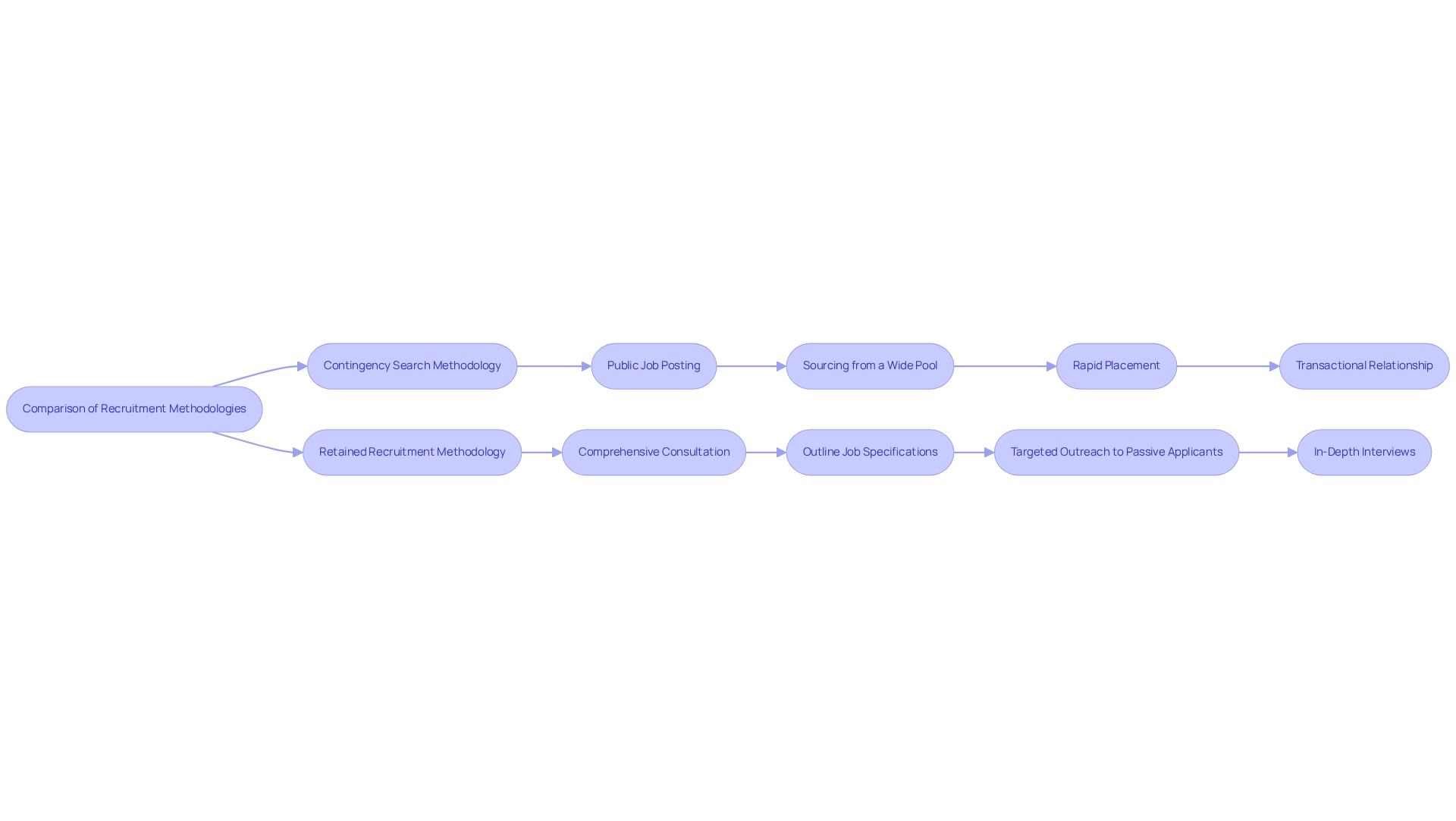
Real-Life Case Studies: Success Stories in IT Recruitment
In today’s competitive tech landscape, aligning talent with technology needs is paramount. Organizations are increasingly overcoming recruitment challenges by leveraging either contingency or retained search strategies.
Case Study 1: A burgeoning tech startup, in collaboration with Bristow Holland, adopted a contingency search approach to swiftly fill multiple entry-level positions. This strategy not only accelerated their hiring process but also cultivated a diverse talent pool, facilitating rapid team expansion and fostering innovation. By prioritizing diversity, the startup enhanced its decision-making capabilities and overall productivity, reflecting a growing trend towards inclusivity in tech roles.
Case Study 2: A large enterprise sought the expertise of Bristow Holland as a retained search firm to identify a new Chief Technology Officer (CTO). This engagement facilitated a comprehensive vetting process, ultimately leading to the selection of an individual who possessed not only the requisite technical skills but also a strong alignment with the company’s culture and long-term vision. The focus on cultural fit and diversity in leadership positions proved advantageous for the organization, underscoring the significance of including women and individuals from varied backgrounds in essential roles.
Case Study 3: A cybersecurity firm faced significant challenges in sourcing specialized talent. By opting for a retained search strategy with Bristow Holland, they successfully employed an individual whose expertise significantly improved their security posture, showcasing the effectiveness of this method in meeting specialized hiring needs. This case highlights the importance of having a diverse range of skills and perspectives in critical roles, particularly as the tech industry evolves.
These examples illustrate the distinct benefits of both hiring approaches, particularly when comparing contingency versus retained search. Customized strategies can lead to successful outcomes in the competitive tech sector. Moreover, with leading job candidates typically remaining accessible for only around 10 days in the job market, the importance of efficient hiring strategies cannot be overstated. As Matt Ackerson noted, “56% of Workers Are Looking for a New Job,” emphasizing the need for companies to act swiftly.
Companies that prioritize diversity in their hiring processes, like Bristow Holland, also experience improved decision-making and productivity, reinforcing the necessity of a strategic approach to recruitment.
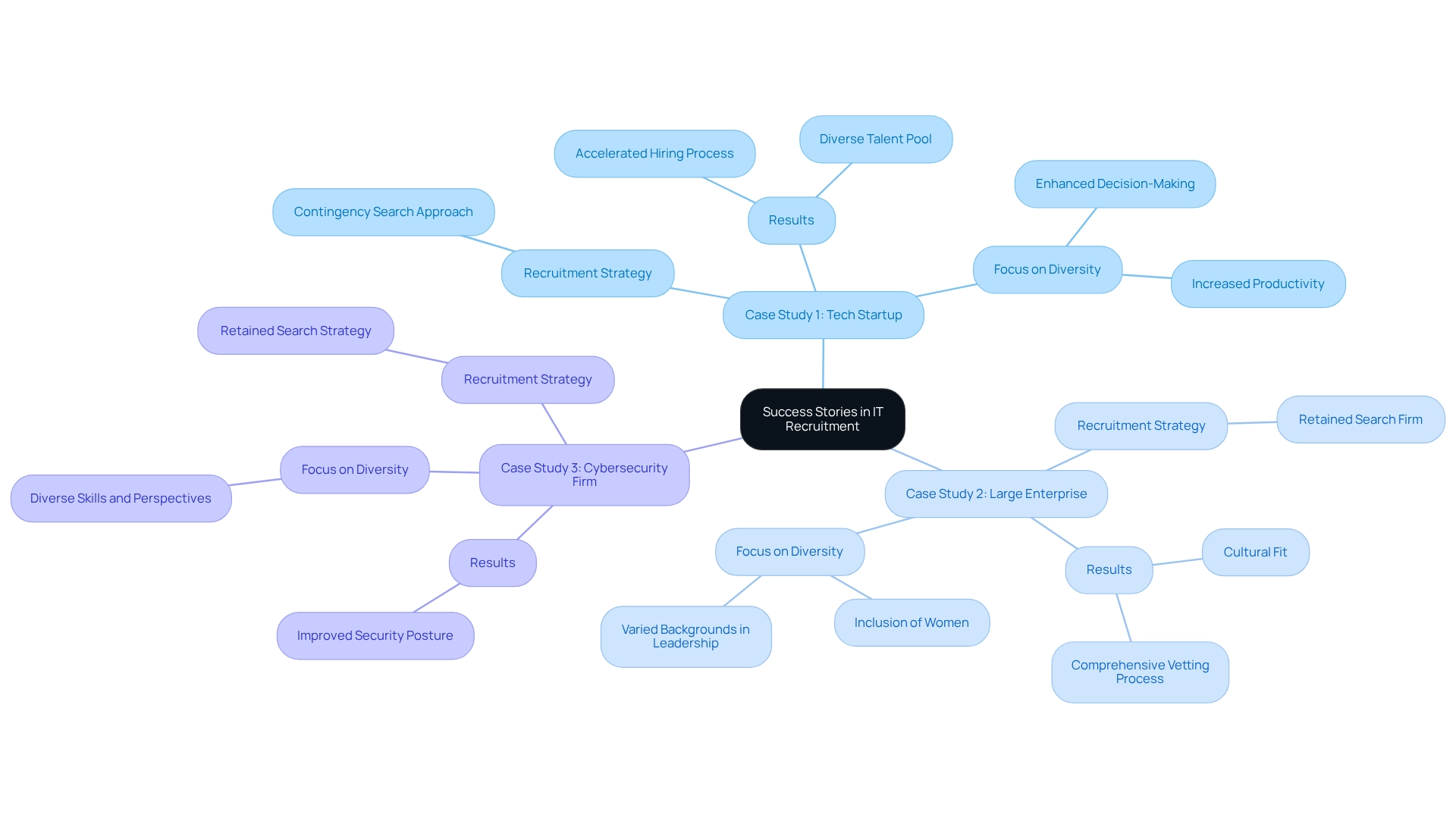
Key Takeaways: Making the Right Choice for Your IT Recruitment Needs
Selecting between contingency and retained services requires a thorough evaluation of various essential aspects.
Role Requirements: Begin by assessing the degree of specialization and complexity of the role. High-level or niche positions often benefit from a retained search, particularly when comparing contingency versus retained search, as dedicated resources are allocated to find the ideal candidate. Bristow Holland specializes in various areas of IT hiring, ensuring that the right expertise is applied to each search.
Urgency vs. Quality: Organizations must strike a balance between the urgency of filling a position and the quality of the candidate. While contingency versus retained search can expedite the hiring process, it may not always yield the best fit for the role. For instance, Bristow Holland has supported hundreds of SaaS companies in their growth, demonstrating the effectiveness of their recruitment strategies in ensuring quality placements. Their commitment to swift applicant shortlists allows clients to anticipate prompt responses without sacrificing quality.
Budget Constraints: Financial implications significantly influence the decision-making process. When discussing contingency versus retained search, it is crucial to note that retained inquiries typically involve upfront fees, which can be justified by the quality of candidates and the thoroughness of the process. Bristow Holland offers transparent pricing and clear explanations for expenses, assisting clients in understanding the value of their investment.
Long-Term Relationships: Partnering with a staffing agency can provide ongoing support for future hiring needs. A conducted search fosters a deeper understanding of the organization’s culture and requirements, leading to better long-term placements. Bristow Holland’s dedication to delivering quality candidates is reflected in client satisfaction and an expanding reputation as a reliable ally in technology hiring.
Incorporating these factors can significantly enhance the efficiency of hiring strategies, ensuring that organizations not only fill roles but also secure individuals who align with their long-term objectives. Companies reassessing their hiring methods often discover that the choice between contingency versus retained search leads to higher satisfaction rates and better cultural fits, ultimately contributing to lower turnover and increased productivity. Furthermore, the integration of AI in hiring processes, as highlighted in a recent case study, illustrates how technology can enhance applicant engagement while maintaining a balance with human interaction.
As Anh Nguyen, a content creator and HR software reviewer, emphasizes, understanding the recruitment landscape is vital for making informed decisions in this area.
Call to Action: If you’re ready to explore tailored recruitment solutions that align with your organization’s needs, contact Bristow Holland today to discuss how we can assist you in finding the right talent.
Frequently Asked Questions:
- How soon can you provide a shortlist of applicants?
As soon as you specify the role you need to fill and the exact skills you are seeking, we can start reaching out to relevant contractors who will be a good fit for your job. We aim to find a solution as quickly as possible, and within 24 hours, we should have spoken to a selection of suitable candidates and sent you their profiles/CVs with our recommendations for your review. - Why are contractors so much more expensive?
They may appear costly compared to a permanent employee, but they cover many expenses that you do not have to worry about. As sole traders or limited companies, they are responsible for paying all their own tax and national insurance out of their fees, as well as any professional insurance, subscriptions to professional bodies, and, of course, all their own training costs. They do not receive any holiday allowance, Christmas bonus, or sick pay. Additionally, the advanced skills they bring to a workplace can significantly enhance efficiency, reduce time-to-completion, and add value to the finished product.
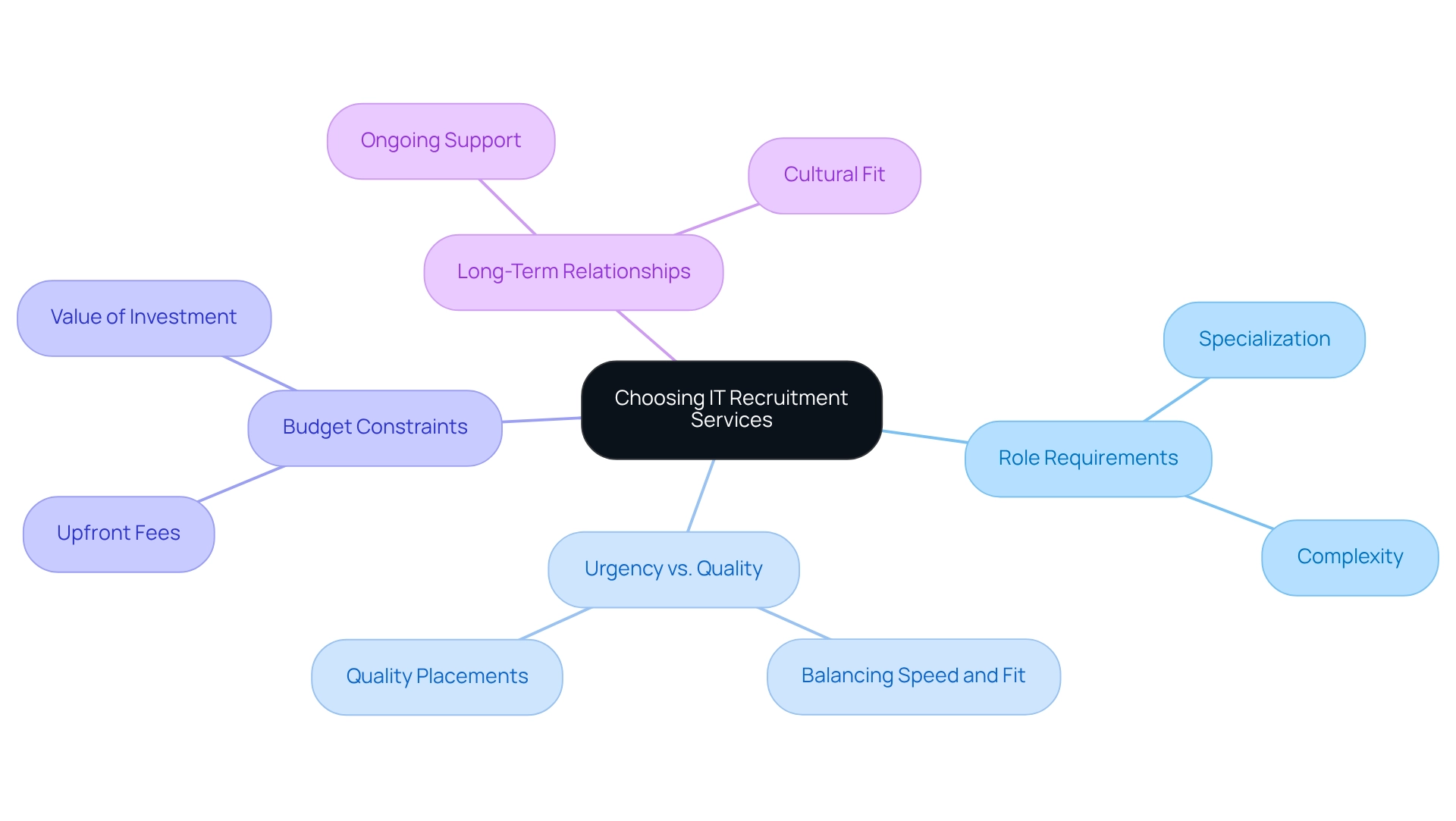
Conclusion
Understanding the distinctions between contingency and retained search models is essential for organizations striving to optimize their recruitment strategies in the dynamic tech industry. Contingency search provides cost-effectiveness and speed, making it an appealing choice for swiftly filling lower-tier positions. However, it may lack the depth of vetting necessary for specialized or executive roles. Conversely, retained search prioritizes a thorough and strategic approach, facilitating a comprehensive evaluation of candidates to ensure alignment with both technical skills and organizational culture.
As the demand for specialized talent escalates, the decision between these two models must reflect the organization’s specific needs, the urgency of filling positions, and the long-term implications of candidate fit. Organizations investing in retained search frequently experience lower turnover rates and enhanced employee satisfaction, owing to a focus on quality placements.
Ultimately, the decision should stem from a careful assessment of role requirements, urgency, budget considerations, and the aspiration for a long-term partnership with a recruitment firm. By aligning recruitment strategies with organizational goals and industry trends, IT directors can significantly elevate their talent acquisition efforts, driving sustainable success within their teams. Embracing the right recruitment model can yield a lasting impact, ensuring that companies secure the best talent to adeptly navigate the complexities of the ever-evolving tech landscape.
Frequently Asked Questions
What is contingency recruitment?
Contingency recruitment is a model where agencies receive payment only upon the successful placement of a candidate. It is advantageous for quickly filling lower-tier positions without upfront costs.
How does retained recruitment differ from contingency recruitment?
Retained recruitment involves a contractual agreement where a recruiter is paid a retainer fee in advance to conduct a thorough search for candidates. This model is typically used for higher-level or specialized roles and fosters a deeper partnership between the recruiter and the client.
When should organizations consider using contingency recruitment?
Organizations may opt for contingency recruitment when they need to fill roles quickly, particularly in fast-paced industries like IT, where there is a high demand for skilled professionals.
What are the benefits of retained recruitment?
The benefits of retained recruitment include access to passive candidates, a thorough vetting process, long-term partnerships with recruiters, and confidentiality for sensitive roles.
Why is the vetting process important in retained recruitment?
The vetting process is crucial because it ensures candidates possess the necessary technical skills and align with the company culture, reducing the risk of high turnover rates.
How does retained recruitment support diversity initiatives?
The retained search model often incorporates commitments to diversity initiatives and bias training, which enhances workplace diversity and belonging.
What current trends are influencing hiring models in 2025?
Trends such as flexibility in work arrangements and personalized employee benefits are becoming key priorities for employee retention, impacting the selection of hiring models.
What role does employee advocacy play in hiring?
Employee advocacy is vital in hiring as content shared by employees generates significantly more engagement than official brand messages, leading to higher conversion rates for leads.
What are the cost implications of contingency versus retained recruitment?
While contingency recruitment has lower upfront costs, it may result in higher total recruiting expenses over the long term compared to retained recruitment, which may have higher initial fees but lower turnover and improved employee engagement.
How can organizations enhance their talent acquisition efforts?
By understanding the differences between contingency and retained recruitment models and aligning their hiring strategies with organizational needs and industry trends, organizations can improve their talent acquisition efforts.







